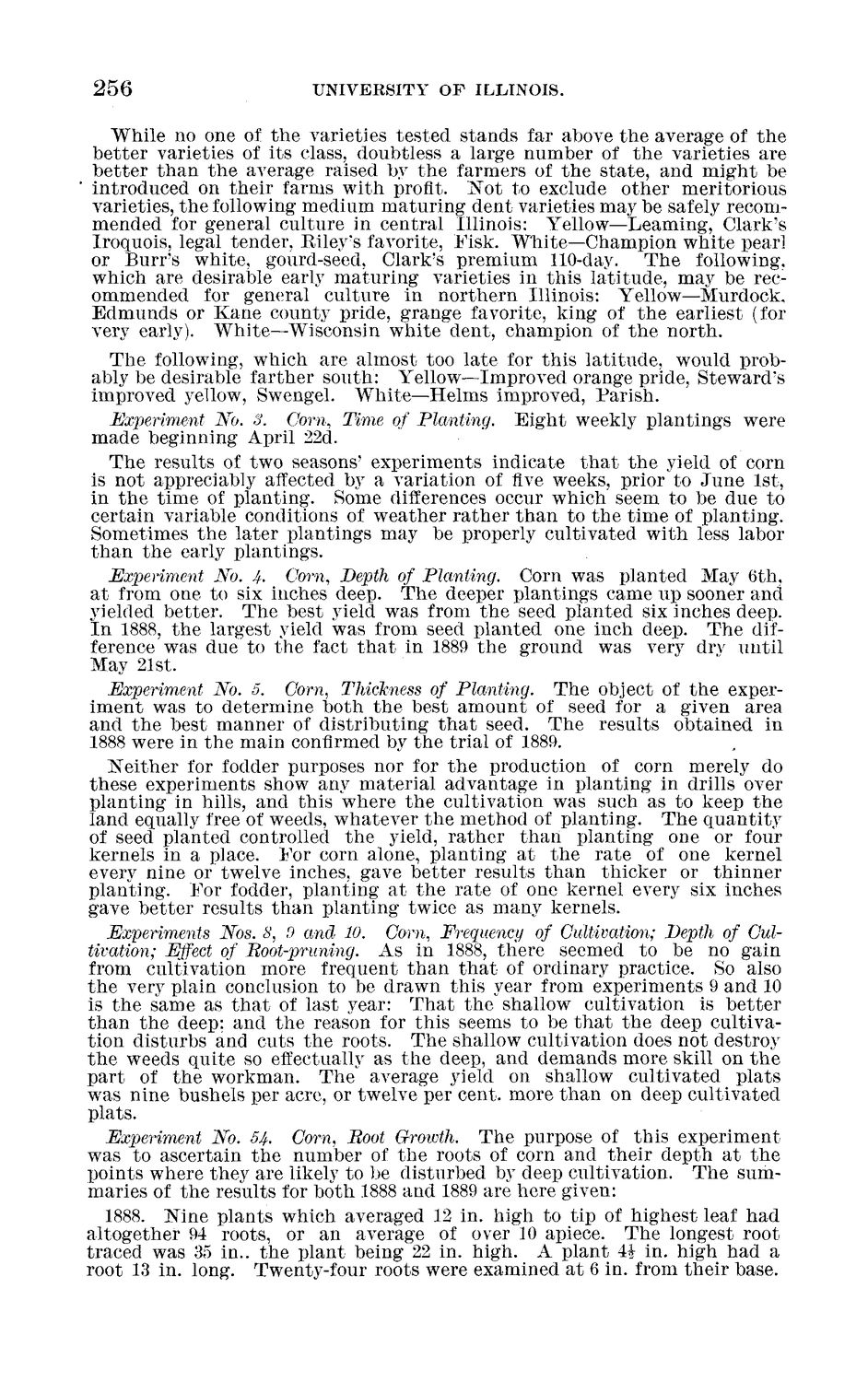| |
| |
Caption: Board of Trustees Minutes - 1890
This is a reduced-resolution page image for fast online browsing.

EXTRACTED TEXT FROM PAGE:
256 UNIVERSITY OF ILLINOIS. While no one of the varieties tested stands far above the average of the better varieties of its class, doubtless a large number of the varieties are better than the average raised by the farmers of the state, and might be introduced on their farms with profit. Not to exclude other meritorious varieties, the following medium maturing dent varieties may be safely recommended for general culture in central Illinois: Yellow—Learning, Clark's Iroquois, legal tender, Riley's favorite, Fisk. White—Champion white pearl or Burr's white, gourd-seed, Clark's premium 110-day. The following, which are desirable early maturing varieties in this latitude, may be recommended for general culture in northern Illinois: Yellow—Murdock, Edmunds or Kane county pride, grange favorite, king of the earliest (for very early). White—Wisconsin white dent, champion of the north. The following, which are almost too late for this latitude, would probably be desirable farther south: Yellow—Improved orange pride, Steward's improved yellow, Swengel. White—Helms improved, Parish. Experiment No. 3. Corn, Time of Planting. Eight weekly plantings were made beginning April 22d. The results of two seasons' experiments indicate t h a t the yield of corn is not appreciably affected by a variation of five weeks, prior to June 1st, in the time of planting. Some differences occur which seem to be due to certain variable conditions of weather rather than to the time of planting. Sometimes the later plantings may be properly cultivated with less labor than the early plantings. Experiment No. 4- Corn, Depth of Planting. Corn was planted May 6th, at from one to six inches deep. The deeper plantings came up sooner and yielded better. The best yield was from the seed planted six inches deep. I n 1888, the largest yield was from seed planted one inch deep. The difference was due to the fact t h a t in 1889 the ground was very dry until May 21st. Experiment No. 5. Corn, Thickness of Planting. The object of the experiment was to determine both the best amount of seed for a given area and the best manner of distributing t h a t seed. The results obtained in 1888 were in the main confirmed by the trial of 1889. Neither for fodder purposes nor for the production of corn merely do these experiments show any material advantage in planting in drills over planting in hills, and this where the cultivation was such as to keep the land equally free of weeds, whatever the method of planting. The quantity of seed planted controlled the yield, rather than planting one or four kernels in a place. For corn alone, planting at the rate of one kernel every nine or twelve inches, gave better results than thicker or thinner planting. For fodder, planting at the rate of one kernel every six inches gave better results than planting twice as many kernels. Experiments Nos. 8, 9 and 10. Corn, Frequency of Cultivation; Depth of Cultivation; Effect of Boot-pruning. As in 1888, there seemed to be no gain from cultivation more frequent than t h a t of ordinary practice. So also the very plain conclusion to be drawn this year from experiments 9 and 10 is the same as t h a t of last year: That the shallow cultivation is better than the deep: and the reason for this seems to be t h a t the deep cultivation disturbs and cuts the roots. The shallow cultivation does not destroy the weeds quite so effectually as the deep, and demands more skill on t h e part of the workman. The' average yield on shallow cultivated plats was nine bushels per acre, or twelve per cent, more than on deep cultivated plats. Experiment No. 54. Corn, Boot Growth. The purpose of this experiment was to ascertain the number of the roots of corn and their depth at the points where they are likely to be disturbed by deep cultivation. The summaries of the results for both 1888 and 1889 are here given: 1888. Nine plants which averaged 12 in. high to tip of highest leaf had altogether 94 roots, or an average of over 10 apiece. The longest root traced was 35 in., the plant being 22 in. high. A plant 4* in. high had a root 13 in. long. Twenty-four roots were examined at 6 in. from their base.
| |